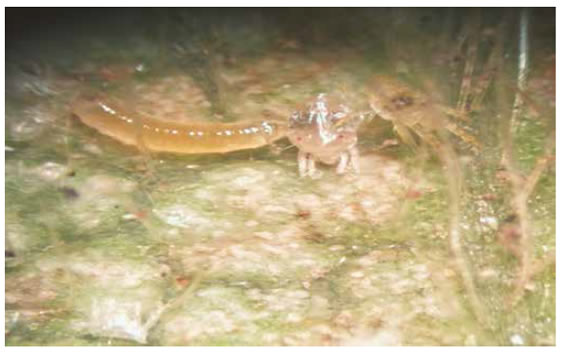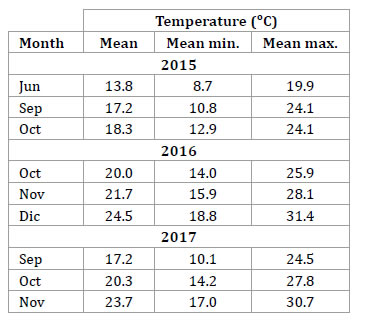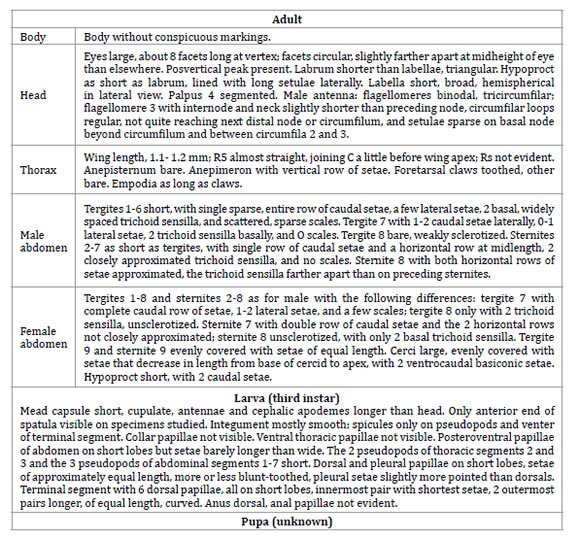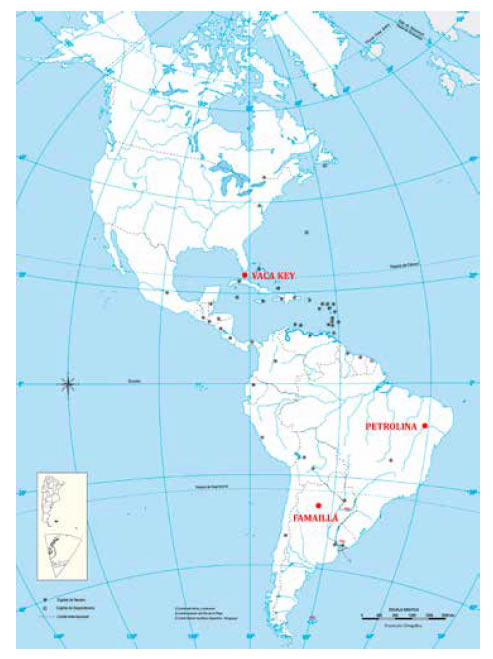
NOTA CIENTIFICA
First record of Feltiella curtistylus Gagné (Diptera: Cecidomyiidae) in Argentina
Primer registro de Feltiella curtistylus Gagné (Diptera: Cecidomyiidae) en Argentina
Claudia Fernanda Funes1, Lorena Inés Escobar1, Braian Eduardo Palavecino1, Daniel Santiago Kirschbaum1
1 Instituto Nacional de Tecnología Agropecuaria (INTA), Estación Experimental Agropecuaria Famaillá. Ruta Prov. 301, Km 32. (4132) Famaillá, Tucumán. Argentina. kirschbaum.daniel@inta.gob.ar
Originales: Recepción: 03/07/2018 - Aceptación: 23/10/2018
ABSTRACT
The first records of Feltiella curtistylus Gagné (Diptera: Cecidomyiidae) in Argentina are reported. Larvae from this species were captured in strawberry (Fragaria x ananassa Duch.) leaflets heavily infested with Tetranychus urticae Koch (Acari: Tetranichidae) in Famaillá, province of Tucumán, Argentina (27°03’S, 65°25’W). In 2015 (June, September and October), 16 larvae were collected; in 2016 (October, November and December), 23 larvae; and in 2017 (September, October and November), 49 larvae. Since F. curti-stylus was found associated to a mite of agricultural importance in strawberry crops. This predatory gall midge has a potential for being considered a biological control agent.
Keywords: Predatory gall midge; Tetranychus urticae; Strawberry; Biological control
RESUMEN
Se presenta los primeros registros de Feltiella curtistylus Gagné (Diptera: Cecidomyiidae) en Argentina. Las larvas de esta especie fueron capturadas en folíolos de frutilla (Fragaria x ananassa Duch.) fuertemente infestados con Tetranychus urticae Koch (Acari: Tetranichidae) en Famaillá, provincia de Tucumán, Argentina (27°03'S, 65°25'O). En 2015 (junio, septiembre y octubre) se recolectaron 16 larvas; en 2016 (octubre, noviembre y diciembre), 23 larvas; y en 2017 (septiembre, octubre y noviembre), 49 larvas. Dado que F. curtistylus se encontró asociado a un ácaro de importancia agrícola en los cultivos de frutilla, este mosquito depredador tiene un potencial para ser considerado un agente de control biológico.
Palabras clave: Mosquito depredador; Tetranychus urticae; Frutilla; Control biológico
The genus Feltiella (Diptera: Cecidomyiidae), represented by 10 species, is cosmopolitan and its larvae almost exclusive predators of red spider mites (Acari: Tetranychidae) (5, 6).
Argentina cultivates ≈1300 ha of strawberries (Fragaria x ananassa Duch.) and produces ≈45500 t/ year, with the strawberry industry being very important from both, social and economic points of view (9). Surveys of the arthropod fauna associated with strawberry crops in Argentina, indicated that the most abundant species is Tetranychus urticae Koch (Acari: Tetranychidae) (10), an important strawberry pest that causes growth retardation and decreased production and quality (3).
The larval stage of Feltiella, as described for F. acarisuga (Vallot), the most studied species of this genus, feeds on all of the developmental stages of spider mites, from eggs to adults (1). During three annual strawberry (Fragaria x ananassa Duch.) production seasons (2015, 2016 and 2017), strawberry leaflets infested with two-spotted spider mites (T. urticae) were collected, taken to the lab and observed by light microscopy at INTA’s Estación Experimental Agropecuaria Famaillá (Tucumán province, Argentina; 27°0’S, 65°2’W, 363 m altitude). Many of those leaflets presented Diptera larvae feeding on eggs, protonymphal and adult stages of two-spotted spider mites (figure 1, page 316).

Figure 1. Feltiella curtistylus larva feeding from two-spotted spider mites on the abaxial underside of a strawberry leaf.
Figura 1. Larva de Feltiella curtistylus se alimenta de arañuelas roja en la parte abaxial de una hoja de frutilla.
In 2015 (June, September and October), 16 larvae were collected; in 2016 (October, November and December), 23 larvae; and in 2017 (September, October and November), 49 larvae. Mean monthly temperatures in which gall midges larvae were collected are presented in table 1 (page 316).
Table 1. Temperatures (mean, mean minimum and mean maximum) of months in which F. curtistylus larvae were collected from strawberry leaves in the 2015-17 period.
Tabla 1. Temperaturas (media, media mínima y media máxima) de los meses en que se recolectaron larvas de F. curtistylus de hojas de frutilla en el período 2015-2017.

A total of 58 leaflets with 83 larvae were placed in Petri dishes with the bottom covered by smooth plaster base, and kept humid until adults emerged. Adult specimens (males and females) were preserved in 70° alcohol and sent to Raymond J. Gagné, Washington DC, USA for identification. They were identified as Feltiella curtistylus Gagné (table 2, page 217), which is the first record of this species in Argentina.
Table 2. Morphology of F. curtistylus. Adapted from Gagné (1984).
Tabla 2. Morfología de F. curtistylus. Adaptado de Gagné (1984).

Some of the collected specimens were deposited in INTA Famaillá and Smithsonian Institution (USNM), Washington, DC, USA collections.
Thus far, in South America, F. curtistylus was known only from Petrolina (9°23'34"S, 40°30'28"W), state of Pernambuco, Brazil (4), associated with Tetranychus evansi (6), one of the main tomato pests in Brazil’s Northeastern Region (8). Specimens of this cecidomyiid were also captured in mosquito traps in Vaca Key, Florida, USA (24°43'1.2’’N, 81°4'22.8’’W) (7). From 10 species of Feltiella worldwide known, only F. insularis Felt has been found in Argentina, more precisely in La Plata city horticultural belt (Buenos Aires province), associated with T. urticae in tomato crops (2).
This is the first record of F. curtistylus in Argentina, and the first time this predator has been found associated with T. urticae. Its adaptive capacity is noteworthy, since it was found in different environments/ climates, separated by thousands of kilometers, within the American continent (table 3 and figure 2, page 318).
Table 3. Dispersion of Feltiella curtistylus Gagné in the American continent: characteristics of the sites where the insect has been reported, including the present record.
Tabla 3. Dispersión de Feltiella curtistylus Gagné en el continente americano: características de los sitios donde se ha reportado el insecto, incluido el registro actual.


Figure 2. Locations where F. curtistylus has been found in the American continent.
Figura 2. Ubicaciones donde se ha encontrado F. curtistylus en el continente americano.
This finding should be complemented with bioecological studies of F. curtistylus to determine its role in the strawberry agroecosystem, since it would compete for its prey with other predators regularly found in strawberry crops in Argentina, such as Phytoseiulus longipes Evans and Neoseiulus californicus (Mc Gregor) (Acari: Phytoseiidae), Orius sp. (Hemiptera: Anthocoridae) and Crysoperla externa (Hagen) (Neuroptera: Chrysopidae), among others (10). F. curtistylus could also be considered a potential biological control tool for other strawberry spider mites such as T. cinnabarinus (Boisduval), a serious strawberry pest in Chile (11). Predation bioessays should be carried out to determine the efficacy of F. curtistylus as spider mite predator, and to analyze its potential inclusion in IPM programs.
1. Abe, J.; Ganaha-Kikumura, T.; Yukawa, J. 2011. Morphological features, distribution, prey mites and life history traits of Feltiella acarisuga (Vallot) (Diptera: Cecidomyiidae) in Japan. Appl Entomol Zool. 46: 271-279.
2. Cédola, C. 2002. Primera cita para Argentina de Feltiella insularis (Cecidomyiidae), díptero predador de ácaros tetraníquidos. Rev Soc Entomol Argent. 61: 45-46.
3. Correa, M. V.; Reguilón, C.; Kirschbaum, D. S. 2013. Bioensayos de depredación de Chrysoperla argentina (Insecta: Neuroptera) sobre la arañuela roja (Acari: Tetranychidae) en cultivo de frutilla bajo condiciones de laboratorio (Tucumán). Horticultura Argentina. 32: 76.
4. Gagné, R. J. 1984. Five new species of Neotropical Cecidomyiidae (Diptera) associated with cacao flowers, killing the buds of Clusiaceae, or preying on mites. Brenesia 22: 123-138.
5. Gagné, R. J. 1995. Revision of tetranychid (Acarina) mite predators of the genus Feltiella (Diptera: Cecidomyiidae). Ann Entomol Soc Am. 88: 16-30.
6. Gagné, R. J.; Jaschhof, M. 2017. A Catalog of the Cecidomyiidae (Diptera) of the World. 4º Edition. Digital. 762 p. Available in: https://www.ars.usda.gov/ARSUserFiles/80420580/ Gagne_2017_World_Cat_4th_ed.pdf
7. Hribar, L. J.; Plakidas, J. D. 2011. Collection records for some gall midges from the Florida Keys (Diptera: Cecidomyiidae). Florida Scientist .74: 38-42.
8. Humber, R. A.; Moraes, G. J.; Dos Santos, J. M. 1981. Natural infection of Tetranychus evansi (Acarina: Tetranychidae) by a Triplosporium sp. (Zygomycetes: Entomophthorales) in northeastern Brazil. Entomophaga. 26: 421-425.
9. Kirschbaum, D. S.; Vicente, C. E.; Cano-Torres, M. A.; Gambardella-Casanova, M.; Veizaga-Pinto, F. K.; Correa-Antunes, L. E. 2017. Strawberry in South America: from the Caribbean to Patagonia. Acta Horticulturae. 1156: 947-955.
10. Lemme, M. C.; Jaime de Herrero, A. P.; Kirschbaum, D. S.; Nasca, A. J. 1996. Artrópodos asociados al cultivo de la frutilla, Fragaria × ananassa, en Tucumán, Argentina. Vedalia 3: 51-52.
11. Tello-Mercado, V.; Derosas-Arriagada, M. 2014. Estudio preliminar de los efectos letales y subletales de extractos etanólicos de cuatro especies xerófitas del altiplano chileno contra Tetranychus cinnabarinus (Acarina: Tetranychidae). Revista de la Facultad de Ciencias Agrarias. Universidad Nacional de Cuyo. Mendoza. Argentina. 46(2): 135-148.
ACKNOWLEDGEMENTS
We thank to Dr. Raymond J. Gagné (Systematic Entomology Laboratory-ARS-USDA and, Smithsonian Institution, Washington DC, USA) for identification of specimens and critical review of the manuscript.
Financial support was provided by Instituto Nacional de Tecnología Agropecuaria (projects PNHFA1106073, TUSGO1231101 and CIAC940162) and Fondo Nacional de Ciencia y Tecnología- Agencia Nacional de Promoción Científica y Tecnológica (FONCyT-ANPCyT, Argentina), through grant PICT-2013-0604.